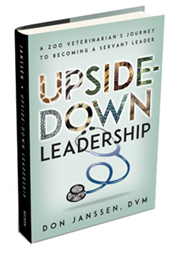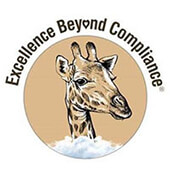Academy Contributors
Four Steps to Develop a Culture of Accountability
By Donald Janssen, DVM
Our hospital manager knocked on my open office door. I looked up as she entered for our weekly meeting. Of all my activities and responsibilities overseeing the health of the animals at San Diego Zoo Global, few were more enjoyable and valuable than my one-on-one meetings with my managers. Each week, I would discover something of crucial importance. Our managers took to heart their huge job responsibilities. As a result, doing my job was much less demanding than it could have been.
Accountability or Servant Leadership?
On this particular day, our hospital manager came prepared with an insightful question. She had joined us just over a year before, and she was trying her best to work within the servant leadership framework. Her problem was how to serve her team while holding them accountable. After further discussion, we realized we had not even come to agreement on what acceptable behaviors looked like.
Our conversation that morning helped me recognize we had a problem. From there, my management team stepped in to find a solution. Several months later, we had a document describing acceptable workplace behavior standards. It was the work of our entire staff, and it described a culture we all wanted to nurture.
Creating workplace standards can be a tricky business, though. We didn't want these standards to convey we cared more about rules than the people they were meant to serve. We had to provide an environment where our staff would hold themselves responsible, feel safe reporting errors, and learn from them. How could we hold people accountable and still serve our staff's needs? We found the following process helpful in answering that question.
Align with Organizational Values
We started with our organization's code of conduct, which included seven statements. That became our foundation. If that had not been available, we would have used other resources, such as value, purpose, and mission statements.
Clarify and Define Expectations
Clarity of roles and responsibilities is vital. Without clarity, holding people accountable for desired behavior is both difficult and unfair. To achieve clarity, we rewrote each of the organization's rules into a catchphrase, so that they reflected the unique nature of our workplace. For example, "Mine the Gold" became the catchphrase "Build Excellence." Then we used an explanatory sentence to sum up and spell out the intent of that catchphrase: "Bring out the best in yourself and others." Finally, we wrote clarifying questions to help identify specific, desirable behaviors—for example, "Am I helping others succeed?"
Ensure Ownership by Staff at All Levels
We enlisted each of our workgroups to provide their input and edits. It was important that each team member had a say in the content. We wanted the front-line staff to take ownership and responsibility.
Apply the Standards with Consistency—and Speak of Them Often
We used the standards to reinforce desired behavior and point out unacceptable behavior. They became a part of our recruitment and hiring process. We desired personal accountability to become part of our culture.
 A Work in Progress A Work in Progress
Behavior-based standards are a must for a healthy work environment. They help make accountability a part of everyone's job and provide safe boundaries within which to work. They become reassuring when implemented in the context of honoring employees and their commitment to the organization.
During my subsequent one-on-one manager meetings, I heard creative ways managers had guided their teams through the use of the standards. Developing a culture of personal accountability will always be a work in progress. However, well-crafted and well-implemented behavior-based standards are useful tools that help turn old methods of accountability upside down. Moreover, attaining that culture can be done best by serving others.
How would you answer the question: As a servant leader, how can I best hold people accountable for their behavior?
To receive a free PDF of our complete Behavioral Standards, send an email request to UpsideDownLeader@gmail.com with "Behavioral Standards" in the subject line.
For more information about this article, please contact Dr. Don Janssen at don.janssen@gmail.com
Leadership insights are contributed by San Diego Zoo Global's retired corporate director of animal health, Dr. Donald Janssen, the first of which appeared in the March 2019 issue of the Academy newsletter. Click here for the Academy newsletter archive.
To learn more about how to put behavior-based standards in place, read Upside-Down Leadership: A Zoo Veterinarian's Journey to Becoming a Servant Leader. You'll find the book at shopzoo.com, Amazon (including a Kindle version), and Barnes & Noble.
 Getting Better All the Time Getting Better All the Time
Supporting the cause of animal protection: words from the heart
By James F. Gesualdi
Words are singularly the most powerful force available to humanity…
—Yehuda Berg
This Thanksgiving season, let us gratefully acknowledge and realize that we are engaged in the important mission of animal protection. Enhancing and continuously improving animal welfare is a form of animal protection. Seeing to animal and public safety is a form of animal protection. Saving species and their natural habitats is a form of animal protection. Educating our friends, guests, and the young is a form of animal protection. Research relating to animal welfare and wildlife conservation is a form of animal protection. We are a part of the larger cause of animal protection, and that is a good thing for animals and for us. It infuses our work with even deeper meaning and significance. That, in turn, should make our work better, and will further help the cause of animal protection.
Given our engagement in such heady work, we must be mindful of another "cause," namely cause and effect. In this world of ours, the thoughts, words, and actions we bring forth are causes, and as such, they have effects. Those effects can impact our success in striving to advance the cause of animal protection. We must therefore pay attention to taking greater care of the causes we set in motion via our words, so that we act in concert with our shared goal of animal protection.
In recent decades, the zoological world has started to update its vocabulary to reflect its modern mission. A number of previous columns have also touched upon more mindful communication. For example, see "The Magic Power of Words," August 2015, available at August 2015 Academy Newsletter. As we move forward, let us heartfully explore and examine the words we employ, and how well they serve animals and our work on their behalf and for animal protection.
Though well-established and professionally recognized, there are many words that should be considered as candidates worthy of re-examination—and perhaps retirement—from the zoological world. This is not an exercise in superficial spin doctoring, but a moment for critical self-reflection on what we say, how we say it, and the way in which that relates to, advances, or detracts from our values and animal protection.
One example is found in brief comments this author submitted (on my own behalf) with regard to the "Marine Mammal Inventory" required by the Marine Mammal Protection Act (16 U.S.C. § 1361). Therein, it was suggested that the term "inventory" (though contained in the MMPA itself) be replaced by something like "National Register of Marine Mammals" or "National Database of Marine Mammals," so as to recognize that the listed animals are other living beings rather than mere commodities. Granted, this may make some wary, but it is factually correct and clearly in accord with how most of us—and the vast majority of the public—view animals. And, it furthers animal/marine mammal protection to underscore that these are living beings, not easily replaceable widgets (without upending existing law).
An audit of our documents, materials, statements, and websites should yield ample basis for discussion about words, especially words we can improve upon to advance our mission. Before continuing, please know these terms may have worked in the past, and were at one time perhaps an accurate reflection of our consciousness, and the public consciousness. Today, we can do better—and this goes to the very heart of our big-hearted community. Some examples for your respectful consideration include the following.
- Acquisition/disposition: We add or place animals in our facilities because they are in need of a home, or we can provide a better quality of life, or as part of a collective effort to save a species. Sometimes we may transfer an animal or animals for similar reasons, and always with consideration for their interests and well-being. Words like additions, placements, and transfers are more in line with our caring and careful efforts.
- Breeding loan: This is really a temporary placement of a living animal for reproductive purposes and should be identified as such.
- Collection: We care for and protect animals, and they reside in our facilities. Resident animals, animal population, or something similar is more appropriate.
Office of Animal Welfare
It has been reported that New York City has just established the first city Animal Welfare Office to centralize and prioritize coordination and oversight of animal welfare-related matters. Where there is an official, office, or group responsible for something, that something is prioritized. This fosters accountability and responsibility. These are the very reasons for having an executive-level Animal Welfare Officer reporting directly to the CEO, and a broad-based Animal Welfare Leadership Group, as well as direct board engagement with animal welfare. Taken together, these proactive animal welfare-enhancing organizational measures advance animal protection.
Giving Thanks
Giving thanks is such a joy. Thank you for inspiring and reading these words.
Thanks to Dr. Donald L. Janssen, whose thoughtful book Upside-Down Leadership: A Zoo Veterinarian's Journey to Becoming a Servant Leader has become an invaluable part of my mentoring work with young leaders. The wisdom of Dr. Janssen's periodic Academy Newsletter columns is universally well-received, and has spurred this columnist to improve his own efforts.
Special thanks to retiring San Diego Zoo Global President/CEO Douglas G. Myers. In my interactions with Doug, he has always been incredibly gracious and supportive. Doug's kind words and encouragement have always elevated my spirits and work.
We are most fortunate to do what we do each day—administering, cleaning, caregiving, communicating, educating, fixing, maintaining, marketing, securing, and doing the best we can for animals. We are also quite fortunate to have each other, those who support our work on behalf of animals, those who challenge us, and, most importantly, the animals with whom we share this world.
Happy Thanksgiving!
At times our own light goes out and is rekindled by a spark from another person. Each of us has cause to think with deep gratitude of those who have lighted the flame within us.
—Dr. Albert Schweitzer
©2019 James F. Gesualdi, P.C. The opinions expressed herein are solely those of the author. This is not, nor should it be construed as, legal advice. |